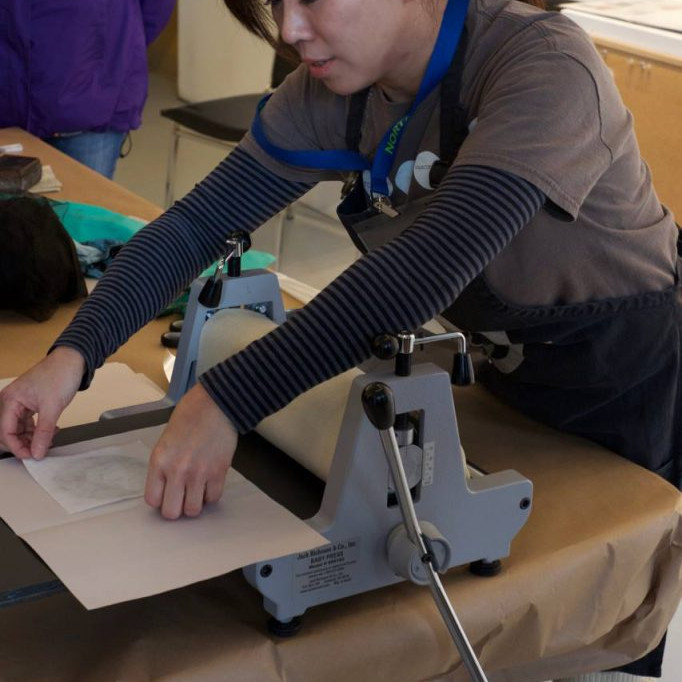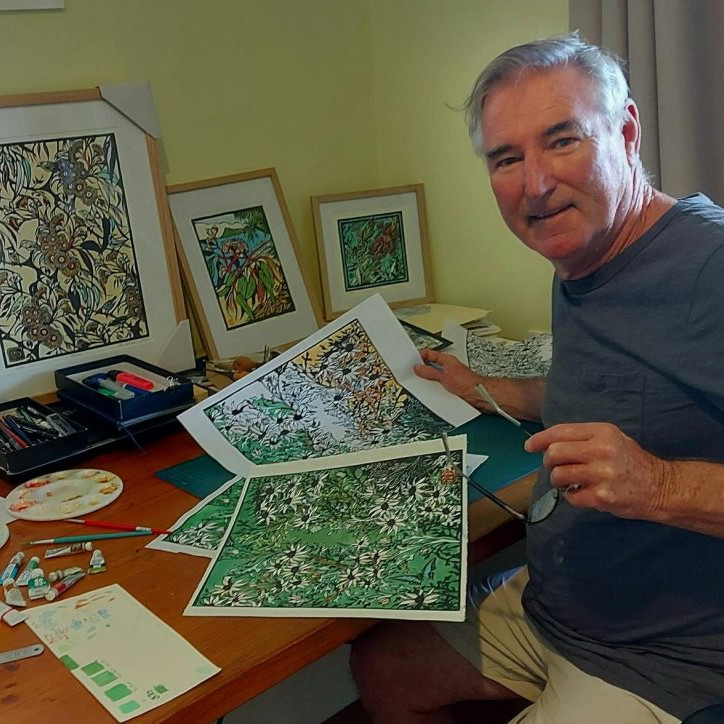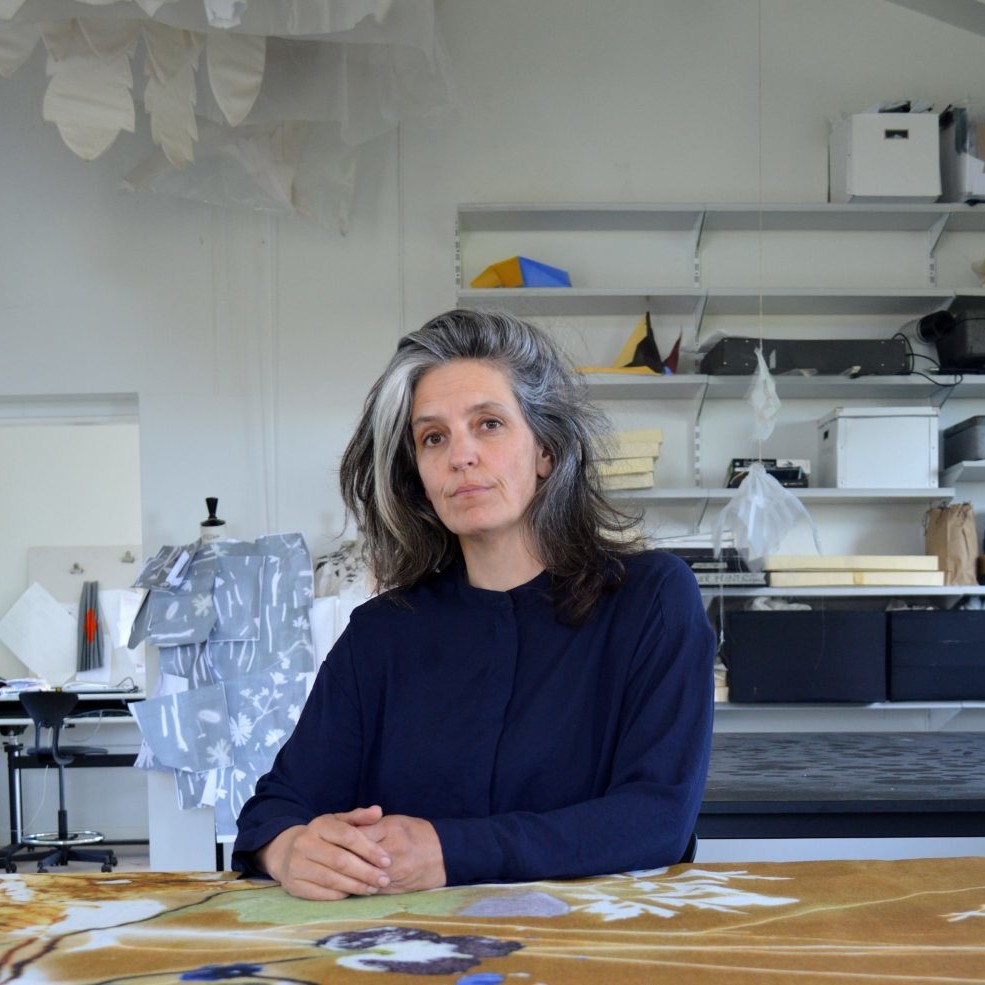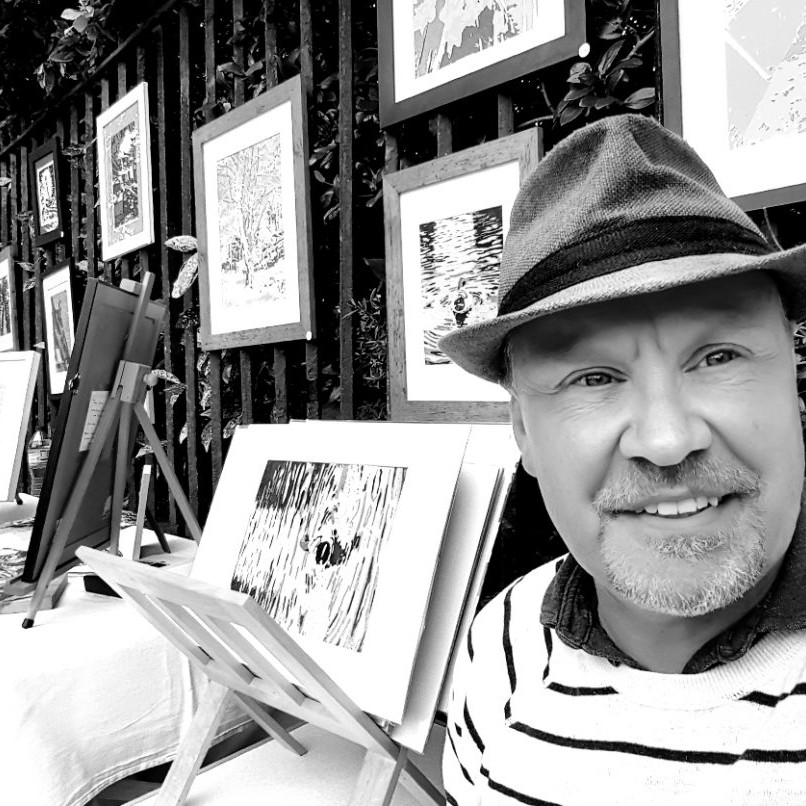Christine McCarthy Printmaker - Adelaide, Australia
Your print making began in 1976 at the South Australian School of Art. Can you explain the importance of Barbara Hanraham in your artistic career?
Barbara Hanrahan was a South Australian printmaker who moved to London in the late 1960.. She was also a novelist.
In my second year at The South Australian School of Art, I was majoring in Painting. Barbara Hanrahan was a resident artist that year in the Printmaking department before returning to London. I was amongst a small group of students doing an elective with her.
She would set us a project and then continue with her own work. Under her influence she established a creative and productive environment. Being able to watch her and see how she went about her prints was very inspirational. I was doing mainly black and white etchings then.
When I had finished my studies I saw an exhibition of Barbara’s work including some hand coloured etchings. It was after this I started experimenting with painting my black and white lino prints.
You also have been greatly influenced by Horoshige can you explain this?
Hiroshige is considered one of the leading exponents of the ukiyo-e landscape view. Many of his prints take as their subject places of beauty in and around the capital, Edo (modern Tokyo). He was influential on European artists including Van Gogh and the French Impressionists. I particularly appreciate his compositions, leading the viewer’s eye into the composition.
His prints were very popular amongst the rising middle class of the time.
In 2000 and 2002 you exhibited in Tokyo, Japan. What was it like to be an Australian taking Lino Prints to the Japanese?
I felt it was quite an honour and humbling to be exhibiting my lino prints in Tokyo, especially considering the Japanese are such masters of woodblock printing, which lino printing has evolved from.
Of course I was able to see many of Hiroshige’s prints, which were on exhibit in Ginza very near to where my exhibition was. It was a great experience learning more about the Japanese culture and the different protocol in the gallery system there. The artist is expected to be present each day of the exhibition. I decided to carve a lino block while I was present at the gallery each day.
It offered me the response to my landscapes and the depiction of space and the fact that the horizon is important in most of my landscapes. People in Tokyo often don’t see the horizon. They were also responsive to my prints of Australian native flora.
Australian flora is a major part of your work. Where do you get the flowers and leaves from?
I am fortunate to live near several parklands which have many native trees and plants in them. The city of Adelaide is bounded by parklands. There is always something in flower. I also have a keen interest in Banksias, I usually purchase these from nurseries which specialize in growing them. If I discover unusual plants at the markets they will be included in a still life. At Corny Point we grow native plants most suitable to the coast which I also like to include in my prints.
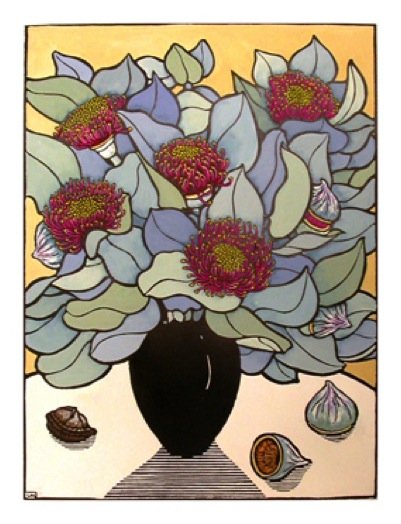
Eucalyptus Macrocarpa
Being Australian is very important to your art. What does capturing Australian flora mean to you?
I have developed a keen interest in Australian native plants over many years. I try to capture the colour, pattern and rhythm of the Australian flora. It is around me and a part of my everyday it is important to express this in my work.
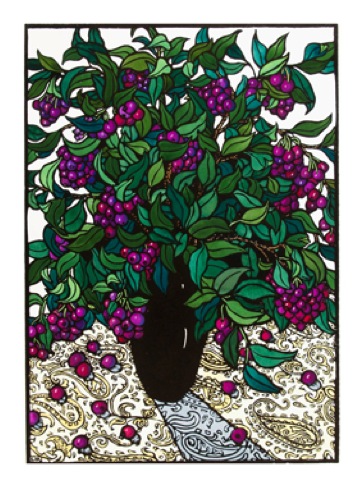
Lilly Pilly on Paisley
Beyond the window, can you tell us about three landscapes you have done recently?
I drew this picture at Mambray Creek in the Flinders Ranges. I wanted to include the Yellow-footed Rock-wallaby which prefers a rocky environment to inhabit. It has recently been taken off the endangered species list. I love the movement of the she oaks and the xanthorrhoea in the foreground. I wanted to show the native plants local to this area and how they survive amongst the rocks.
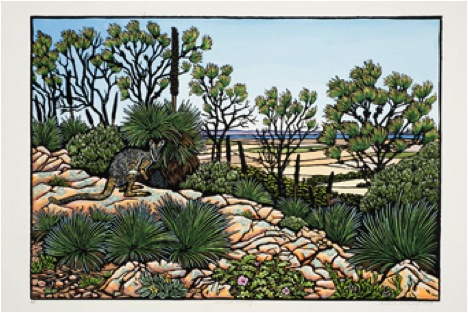
‘Mambray Morning’ 2012
The Mallee fowl’s nest is a work of art in itself. The birds are very shy and create this large mound as an incubator for their eggs. The nests are well hidden in the Mallee scrub. This nest is in Innes National Park on Southern Yorke Peninsula.
I love the Mallee scrub and wanted to illustrate the beautiful pattern of the birds in their environment.
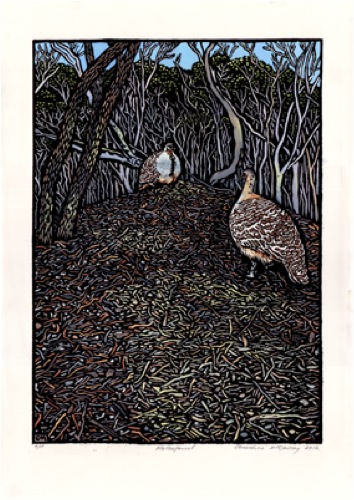
Mallee Fowl 41×30 2012
In this picture I wanted to show the diverse vegetation of the wind swept coast at Corny Point. I marvel at how the plants survive the prevailing winds. The vegetation forms its own tapestry. One often sees Pelicans flying by, appearing to hover overhead. Such majestic birds!
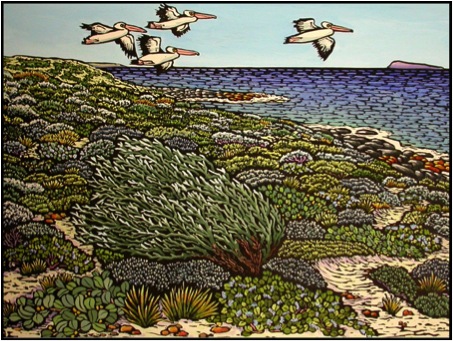
Wedge Island 41×56
Can you briefly explain the process of relief printing?
I transfer the image on to a piece of lino (in reverse – so the image when printed will appear the correct way).
Using a variety of carving tools I carve away the areas which will be coloured in the final picture. This leaves a raised outline and areas of carved textures and patterns. Like a large stamp.
I roll ink over the top of the carved piece of lino (called a block).
The raised areas come in contact with the ink and the carved away areas remain white.
I place a piece of paper (which I have lightly dampened with spring water) over the inked lino block and apply pressure by rolling it through the printing press. This transfers the ink onto the paper.
You don’t need to use a printing press but can apply pressure by rubbing the back of the paper with a wooden spoon or a traditional Japanese barren.
Once the print is dry I paint the first print, which becomes my artist proof.
I then paint the rest of the edition of prints (usually 20 prints) referring to the artist proof. Each print then becomes individual.
You use a Farley Proofing Press, the biggest dilemma to print makers is space and equipment, can you explain your studio situation?
I have a studio in North Adelaide. My work is very transportable. In fact if the weather is fine I prefer to carve outside as the sun softens the lino making it easier to carve. I am able to take my lino to Corny Point when I am there and carve. I also paint my prints at both places.
I am co-owner of an art school, The Ruth Tuck Art School, and although I do not teach any more I have my printing press there. I am fortunate that I have a large space where I can print, especially when I am edition my blocks. I usually do an artist proof in my studio at home first, rubbing the print by hand with a wooden spoon.
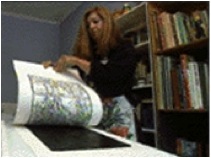
Technical information about Printing.
THE PRINTING PROCESS
Relief printing is the most ancient method of taking an impression from one object and putting it on to another.
The earliest form of relief prints were found in China in the 7th Century.
It was used to spread Buddhism.
• I choose to do my images with lino as I like the contact with the surface in each step of the process. The carving of the lino takes the initial image beyond the drawing and adds a further dimension to it for me. There is the excitement of ‘pulling’ the first print and the hand-colouring, makes it come alive with colour.
• I transfer my drawing (in reverse) onto a piece of lino.
• Using carving tools with various blades, I carve away the areas. I don’t want to print. This forms a relief block, like a stamp.
• I then roll black ink over the carved lino block. The ink comes into contact with the raised areas of the lino.
• Paper is then placed over the inked lino and pressure is put onto the back of the paper by rubbing with a wooden spoon or through a printing press. This transfers the ink from the lino block onto the paper.
• When the print is dry I paint the areas that I have carved away to produce the final image.
• The first print I paint becomes my ‘artist proof’. I then print an edition of 20 prints, which I paint referring to the artist proof. This makes each print individual.
• The prints are on 280gms ‘Magnani’ 100% rag, acid free paper.
I print with Van Son rubber based printing ink and paint with Gouache.
Linoleum is a natural product made from linseed oil and wood flour.
Zoneone Arts would like to thank Christine for giving this printing information to our readers.
Your work has been acquired by many private and government institutions. Can you explain about one or two of these and the impact of these sales have had on your career?
At my first exhibition at The Royal Botanic Gardens in Sydney a member of the Prime Minister’s Department came and purchased three of my works for The Prime Minister’s Department. I don’t think this has harmed my career, I can’t say exactly what affect it has had. At another exhibition in Sydney a person from Japan was very interested in my work and purchased several, which led to my first exhibition in Tokyo.
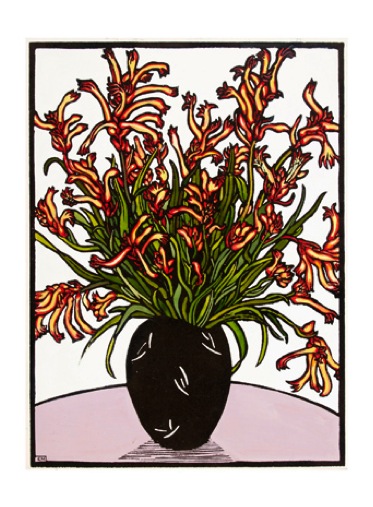
Kangaroo Paws
You work has been in many wineries has it always been on the walls or have you had your work used on wine labels?
I like the rhythm and pattern that the rows of planted vines make on the landscape. It interests me to contrast this with the natural landscape surrounding the vines. Recently I was commissioned by a winery in the Hunter Valley of NSW to do a hand coloured lino print for their label ‘The Pavilion’
How important are exhibitions to your work?
I work all the time because I have ideas I want to interpret into lino prints. Having an exhibition deadline increases the pressure to complete a body of work. It is always interesting to see the framed work up on the gallery wall for the first time. I sometimes discover links between the different images I wasn’t fully aware of before. It takes me about 2 months to complete each image, so to fill a Gallery space is usually 18 months to 2 years in preparation.
How do you organize the numbers of prints you produce? Do you destroy the lino cut after printing?
I usually print an edition of 20 prints.
I like seeing the edition lined up after printing.
There is something pleasurable in seeing the multiple prints, I hand colour each print. I have found this is the number I am happy to hand colour.
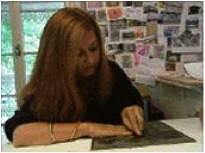
Traditionally each carved block should have a carved line cut through the block and then printed to show the block has been destroyed and no additional prints can be made.
For me, I find the carved block an artwork in itself.
Some blocks take 30 to 40 hours to carve.
It is such an important part of the creative process for me. I cannot bring myself to destroy them.
As each edition is sold out (I keep very accurate records) I write on the back of the block the date it has sold out and store them away.
Where an artist lives has a huge impact on their art. Can you explain the impact of living in Adelaide (city) and Corny Point on the Yorke Peninsula
(Coastal) both in South Australia?
I would be an artist wherever I lived.
Living in North Adelaide is conducive to going for walks – into the city, to the parklands, to Adelaide oval for the cricket. Walking gives you time to stop and look. All these places inspire me and something triggers an idea I record to develop into a lino print. A continuing theme for me is the contrast between the manmade and the natural environment.
As having a place on the coast I have become more interested in the changing seasons and the farmed land against the natural coastal vegetation.
My interest in Australian flora is a constant in both places.
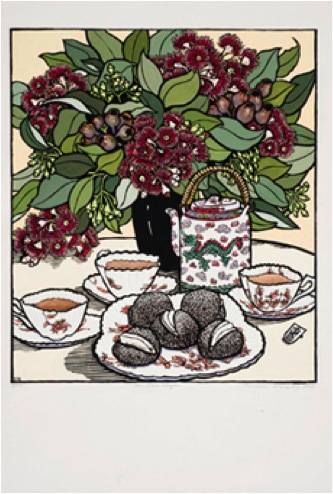
Year of the Dragon
Christine McCarthy, Adelaide, Australia.
Interview by Deborah Blakeley, November, 2012
Think a colleague or friend could benefit from this interview?
Knowledge is one of the biggest assets in any business. So why not forward this on to your friends and colleagues so they too can start taking advantage of the insightful information the artist has given?
Other artists you may be interested in:



